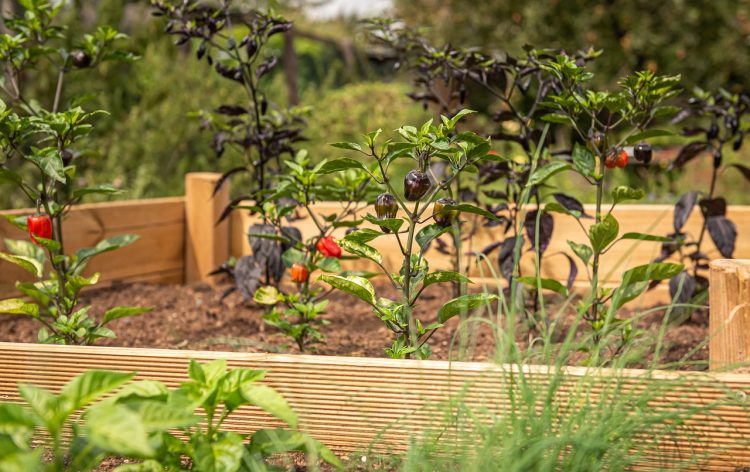Raised bed gardening is a versatile and effective way to grow vegetables, herbs, and flowers. By creating a raised growing area, you can have better control over soil quality, reduce problems with weeds, and enjoy easier access for planting and harvesting. Whether you’re a beginner or an experienced gardener, raised beds can help you create a more productive and enjoyable garden. This ultimate guide will walk you through everything you need to know about setting up and maintaining a successful raised bed garden.
Benefits of Raised Bed Gardening
Raised bed gardening offers several advantages over traditional in-ground gardening. One of the biggest benefits is improved soil quality. By filling your raised bed with high-quality soil, you can create the ideal environment for your plants, regardless of the natural soil conditions in your area. Raised beds also allow for better drainage, which is especially beneficial if you have heavy clay soil that tends to stay waterlogged.
Another benefit of raised beds is easier access. The elevated height of the bed makes planting, weeding, and harvesting more comfortable, especially for those with back or mobility issues. Raised beds also help keep weeds at bay, as the defined growing area makes it easier to control unwanted plants. Additionally, raised beds can be designed to be aesthetically pleasing, adding a structured and attractive element to your garden.
Choosing the Right Location
The location of your raised bed is crucial to the success of your garden. Most vegetables and herbs require at least six to eight hours of sunlight each day, so choose a spot that gets plenty of direct sunlight. If possible, place your raised bed near a water source to make irrigation easier.
The ground beneath your raised bed should be level to ensure even watering and prevent soil erosion. If your chosen area has poor drainage, consider placing a layer of gravel or coarse sand at the bottom of the bed to improve drainage. Be mindful of nearby trees and shrubs, as their roots can invade your raised bed and compete with your plants for nutrients and water.
Building Your Raised Bed
Raised beds can be built from a variety of materials, including wood, stone, concrete blocks, or metal. When choosing a material, consider both the aesthetic appeal and the durability. Wood is a popular choice for raised beds because it’s easy to work with and relatively inexpensive. Cedar and redwood are great options, as they are naturally rot-resistant. Avoid using treated lumber, as the chemicals can leach into the soil and harm your plants.
To build a simple raised bed, use untreated wooden planks to create a rectangular frame. The ideal height for a raised bed is between 12 to 18 inches, but you can make it taller if needed for accessibility. Secure the corners with screws or brackets, and make sure the bed is level before filling it with soil. If you are building multiple beds, leave enough space between them for easy access—at least two to three feet is recommended.
Filling Your Raised Bed with Soil
The quality of the soil in your raised bed is one of the most important factors in the success of your garden. A good soil mix should be rich in organic matter, well-draining, and loose enough to allow roots to grow freely. A common recommendation for raised bed soil is a mix of one-third garden soil, one-third compost, and one-third peat moss or coconut coir. This combination provides the right balance of nutrients, aeration, and moisture retention.
If you’re starting with poor soil, consider adding additional compost, aged manure, or other organic amendments to improve fertility. You can also use commercial raised bed soil mixes, which are designed to provide the right balance of nutrients and texture for optimal plant growth. Make sure to fill the bed to the top, as the soil will settle over time.
Choosing Plants for Your Raised Bed
One of the great things about raised bed gardening is that you can grow almost anything in a raised bed, from vegetables and herbs to flowers and small fruit bushes. When choosing plants, consider the amount of sunlight your raised bed receives and the growing conditions you can provide.
Vegetables like tomatoes, peppers, lettuce, carrots, and beans are well-suited to raised beds. Herbs such as basil, parsley, thyme, and rosemary also thrive in raised beds, as do flowering plants like marigolds and zinnias. Consider companion planting to maximize space and create a healthier garden ecosystem. For example, planting marigolds alongside tomatoes can help deter pests, while basil can enhance the flavor of your tomatoes.
Planting in Your Raised Bed
When it’s time to plant, start by laying out your garden plan. Make sure to provide enough space for each plant to grow to its full size. Overcrowding can lead to poor air circulation and increased susceptibility to pests and diseases. Use the square-foot gardening method to make the most of your space by dividing the bed into square-foot sections and planting according to the recommended spacing for each plant.
Direct sow seeds or transplant seedlings into the raised bed, depending on the plant type. Water thoroughly after planting to help the roots establish. For climbing plants like cucumbers and peas, install trellises at the time of planting to provide support as they grow.
Watering Your Raised Bed Garden
Proper watering is essential for the health of your raised bed garden. Raised beds tend to drain more quickly than in-ground gardens, so you may need to water more frequently, especially during hot weather. Water deeply to encourage deep root growth, but avoid overwatering, as this can lead to root rot.
The best time to water is early in the morning or late in the afternoon, as this helps reduce evaporation and allows plants to absorb moisture before the heat of the day. Consider installing a drip irrigation system or soaker hoses to provide consistent moisture without wasting water. Mulching the surface of the soil with straw, shredded leaves, or grass clippings can also help retain moisture and reduce the need for frequent watering.
Fertilizing and Maintaining Your Raised Bed
Raised beds can become nutrient-depleted over time, especially if you grow heavy-feeding plants like tomatoes or squash. To keep your plants healthy and productive, apply a balanced, organic fertilizer every few weeks during the growing season. Compost tea or fish emulsion are excellent choices for providing a gentle nutrient boost without overloading the soil.
In addition to fertilizing, regular maintenance is key to keeping your raised bed garden thriving. Remove weeds as soon as they appear to prevent them from competing with your plants for nutrients and water. Prune any dead or damaged leaves to improve air circulation and reduce the risk of disease. Check for pests regularly, and use natural pest control methods, such as insecticidal soap or neem oil, if needed.
Extending the Growing Season
One of the advantages of raised bed gardening is the ability to extend the growing season. Raised beds warm up more quickly in the spring, allowing you to plant earlier than you would in an in-ground garden. To protect your plants from late frosts, consider using row covers, cloches, or cold frames.
In the fall, you can also use row covers or a hoop house to protect your plants from cold temperatures and extend the harvest. By adding these simple structures to your raised bed, you can enjoy fresh vegetables well into the cooler months.
Crop Rotation and Soil Health
To maintain healthy soil in your raised bed, practice crop rotation. Crop rotation involves changing the types of plants you grow in each bed from year to year. This helps prevent the buildup of pests and diseases that target specific plant families and ensures that the soil remains nutrient-rich.
For example, if you grow tomatoes in one bed one year, consider planting a different type of crop, such as beans or leafy greens, in that bed the following year. Legumes like beans and peas are especially beneficial for soil health, as they help fix nitrogen, which is an essential nutrient for plant growth.
Winterizing Your Raised Bed
At the end of the growing season, take steps to prepare your raised bed for winter. Remove any dead plants and debris, and add a layer of compost to replenish nutrients. You can also plant a cover crop, such as clover or rye, to protect the soil from erosion and improve its structure over the winter.
If you live in an area with harsh winters, consider covering your raised bed with a tarp or plastic sheeting to protect the soil from heavy rain or snow. This will help keep the soil in good condition and ready for planting when spring arrives.
Raised bed gardening is a versatile and rewarding way to grow a wide variety of plants. By choosing the right location, building a sturdy bed, and providing proper care, you can create a productive and beautiful garden that brings joy and fresh produce to your home. Whether you’re growing vegetables, herbs, or flowers, raised beds make gardening more accessible, efficient, and enjoyable for everyone.










